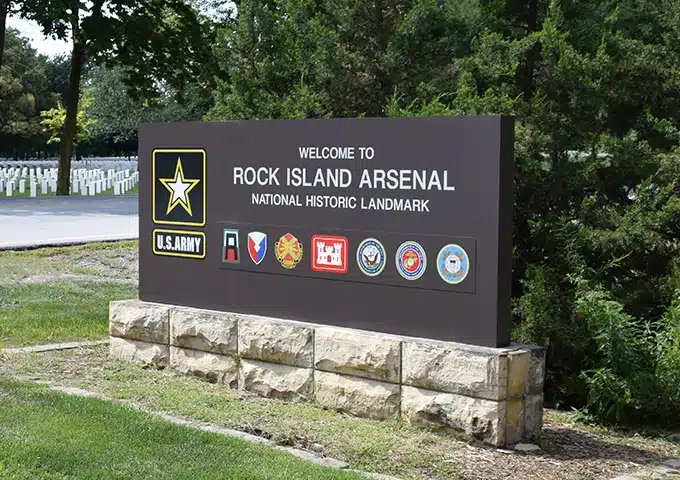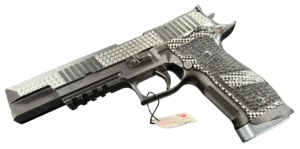Key Takeaways:
- Rock Island Arsenal isn’t just a relic—it’s a living, breathing part of America’s military backbone: From its Civil War roots to cutting-edge tech support today, Rock Island has constantly reinvented itself. It’s not some dusty old factory frozen in time; it’s a place where history meets progress and where weapons, logistics, and strategy still take shape behind those historic stone walls.
- Innovation at Rock Island has always been less about flash and more about function: Sure, the Arsenal produced iconic weapons like the M1 Garand, but its real magic? Quietly making sure soldiers got what they needed, when they needed it—whether it was a refurbished rifle or a revamped logistics system. The place runs on ingenuity, grit, and a deep understanding that reliability wins wars.
- The Arsenal’s impact goes way beyond the military—it’s woven into the local community: Ask someone in the Quad Cities, and they’ll tell you: Rock Island is part of the neighborhood. It fuels jobs, hosts museum exhibits, offers training programs, and bridges the gap between past and present. It’s a defense hub, yes—but it’s also a hometown hero with a serious legacy.
Perched on a 946-acre stretch in the middle of the Mississippi River—right between Davenport, Iowa, and Rock Island, Illinois—sits one of the most enduring symbols of American military innovation: Rock Island Arsenal. Established back in 1862, right in the thick of the Civil War, this place has never been just a manufacturing hub. It’s been a workhorse, a proving ground, and a quiet powerhouse shaping U.S. defense for over 160 years.
From the earliest days of cannon repair to today’s work with digital battlefield systems, the Arsenal has always done one thing well—adapt. And in military history, that’s no small feat.
Where It All Began: War Demands and Bold Ideas
Let’s rewind to the 1800s. Before it was turning out rifles and armored vehicles, the island had been tapped for military use as early as the 1810s with the construction of Fort Armstrong. But it wasn’t until 1862—thanks to Congress and the escalating Civil War—that Rock Island’s real story kicked off.
Initially, the site functioned mostly as a storage and repair center for weapons and gear. That changed pretty quickly. By the 1880s, the Arsenal had shifted into full-blown production under the leadership of General Thomas J. Rodman. Rodman wasn’t just any officer—he was a pioneer in artillery design, and he brought that innovation to Rock Island. He didn’t just want tools that worked—he wanted tools that led.
Under his direction, the Arsenal began to take shape—literally. Those impressive stone buildings still standing today? Rodman’s era. They weren’t just functional; they were built to last and meant to reflect the seriousness of the work inside. Skilled workers from all over the region came for jobs, and the area boomed. By the early 1900s, the Arsenal wasn’t just making guns—it was helping define how the U.S. military equipped itself for the modern world.
When the World Went to War—Twice
World War I marked the Arsenal’s true leap into high-gear production. Demand for arms and supplies exploded, and Rock Island met the call head-on. Thousands of workers filled the floors, turning out rifles, shells, saddles—you name it. The war changed warfare forever, and the Arsenal kept pace.
But it was during World War II that Rock Island Arsenal cemented its reputation as a linchpin of American strength. As the U.S. mobilized for a two-theater war, the Arsenal’s role expanded in ways no one could’ve predicted a generation earlier.
It wasn’t just about churning out weapons, though it did that at scale. It was about precision, speed, and coordination. The M1 Garand? Produced here. Bomb fuses? Here. Replacement parts for everything from artillery to small arms? Again—right here. This wasn’t just a factory. It was a vital organ in what President Roosevelt famously called the “Arsenal of Democracy.”
And the behind-the-scenes work mattered just as much. Rock Island didn’t just make gear—it shipped it, tracked it, and coordinated its delivery to the front lines. Logistics might not make headlines, but ask any soldier in a muddy trench—they’ll tell you how much it matters.
A New Era: The Cold War and a Shift in Focus
After the dust settled in 1945, the U.S. wasn’t done needing Rock Island Arsenal, far from it. The Cold War didn’t demand the same kind of raw volume as World War II, but it did require something arguably harder: smarter systems, better tools, and a constant eye on innovation.
That’s where Rock Island once again proved its worth. As global tension shifted from trench warfare to potential nuclear confrontation, the Arsenal focused more on research, development, and strategic logistics. Engineers and technicians worked on upgrades to artillery systems, armored vehicles, and small arms, adapting military tech to a rapidly changing world.
Behind the scenes, the Arsenal also became a logistics powerhouse. It created intricate systems for storing, maintaining, and moving military gear with speed and efficiency—systems that would eventually become models for supply chain strategies in both military and civilian sectors.
One of its less-talked-about strengths? Refurbishment. Instead of constantly building new gear, Rock Island became the place where equipment got new life. Complex overhauls, modernization of aging systems, and field testing for reliability—this kind of work may not be flashy, but it’s essential when lives depend on what you’re carrying into combat.
And it wasn’t just machines. Rock Island also invested in people. Training programs flourished here for both military and civilian personnel. Whether it was technical skills, logistics management, or leadership training, the Arsenal played a quiet but central role in shaping the next generation of defense professionals.
Still Standing, Still Serving: Rock Island in the 21st Century
Fast-forward to today, and Rock Island Arsenal is still going strong. Sure, it doesn’t look exactly like it did in 1942—there are more screens than rivets, more microchips than metal stock—but the mission hasn’t changed. This place is still about keeping the U.S. military sharp, ready, and well-equipped.
In the modern era, the Arsenal is doing more than just building and repairing. It’s developing complex weapon systems, electronic components, and digital communications tools. And it’s not working in isolation. The facility partners with private industry, academic institutions, and other military installations to stay ahead of the curve.
This new chapter isn’t all about tech, though. Rock Island also plays a major role in preserving history. The Rock Island Arsenal Museum—established in the 1900s—is one of the oldest military museums in the U.S. It’s a treasure trove of weapons, documents, and personal stories. School groups visit, veterans reflect, and visitors get a real sense of just how deep this history runs.
However, to truly understand Rock Island’s impact, speak with someone in the Quad Cities. This place isn’t just a military asset—it’s a local icon. Thousands of civilians work here, and the Arsenal supports a wide range of organizations, from small businesses to public schools, through its economic impact. Community events, outreach programs, veterans’ services—it’s all part of the story.
Legacy in Motion
Here’s the thing—when people think of military history, they often picture battlefields or famous generals. But there’s another story, quieter but just as powerful: the story of the people and places that make the tools, fix the engines, ship the gear, and keep the wheels turning.
That’s Rock Island Arsenal.
It’s not frozen in the past. It’s not just a museum piece. It’s a living, working testament to American resilience. Through wars, technological revolutions, and changing global threats, it’s evolved without losing its core mission: to serve the military, support the nation, and do it with grit, pride, and precision.
So the next time you hear about a weapon system that worked when it mattered, or a logistics chain that didn’t break when pressure was on, remember there’s a good chance Rock Island had something to do with it. And odds are—it still does.
Frequently Asked Questions
It’s more than just a factory or a military base. Rock Island Arsenal is a working U.S. Army installation on an island in the Mississippi River. It has been in operation since the Civil War. It has evolved into a key site for manufacturing, repairing, and maintaining military equipment, encompassing everything from rifles and artillery to modern communication systems. Think of it as both a cornerstone of military logistics and a living piece of American history.
Congress officially established it in 1862, during the heart of the Civil War. The Union needed more resources—fast—and Rock Island’s location made it ideal for moving equipment up and down the Mississippi. Initially, it was used solely for storage and repairs. However, it quickly evolved into a significant manufacturing center thanks to leadership like General Thomas Rodman, who wasn’t afraid to build big and think even bigger.
Short answer: a lot. During World War I and World War II, it helped produce everything from artillery shells to bomb fuses to M1 Garand rifles. In peacetime, the Arsenal shifted gears—literally. It has played a significant role in refurbishing gear, building logistics systems, and staying ahead of the curve with new technology. Whether it’s saddle parts or digital battlefield systems, Rock Island has probably touched it.
Very much so. While its focus has evolved with the times, it remains an essential part of the U.S. Army’s operations. These days, it works on high-tech systems—think electronics, software integration, and modern weapons platforms. It also trains personnel and manages complex logistics. It’s not stuck in the past—it’s helping shape the future.
A huge one. During World War II, Rock Island became part of the “Arsenal of Democracy”—a nationwide effort to outproduce the Axis powers. Thousands of workers turned out a staggering volume of military equipment. But just as important was its behind-the-scenes work: coordinating logistics, testing new designs, and ensuring that what was shipped to the front worked when it arrived.












